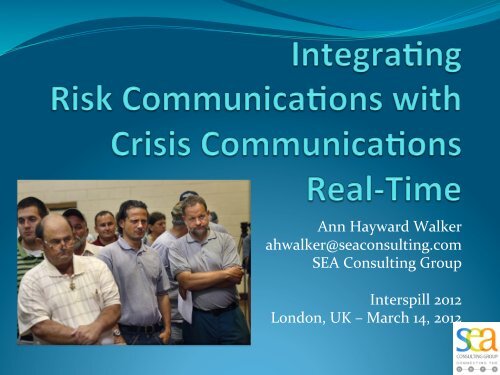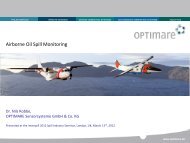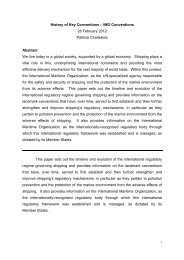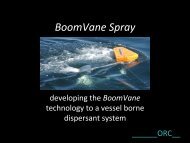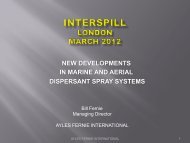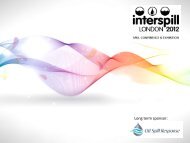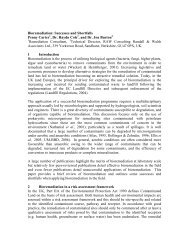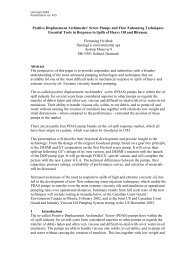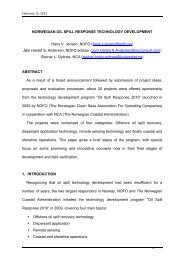Oil Spill Risk Communications
Oil Spill Risk Communications
Oil Spill Risk Communications
Create successful ePaper yourself
Turn your PDF publications into a flip-book with our unique Google optimized e-Paper software.
Ann Hayward Walker<br />
ahwalker@seaconsulting.com<br />
SEA Consulting Group<br />
Interspill 2012<br />
London, UK – March 14, 2012
<strong>Oil</strong> <strong>Spill</strong> <strong>Risk</strong> Communica1ons <br />
• <strong>Risk</strong> perceptions influence <br />
judgments, opinions, fears, <br />
beliefs, and decisions regarding: <br />
– Will a perceived risk cause me <br />
harm <br />
– And, ultimately, response actions, <br />
claims and lawsuits <br />
– Poor understanding about, e.g., <br />
– The system of oil spill response <br />
– Dispersants and in situ burning <br />
– Seafood safety
Crisis Communica1ons <br />
<strong>Communications</strong> from external affairs and <br />
public relations with a <br />
Rapid response capability <br />
Use media to influence public beliefs, <br />
opinions, and judgments <br />
Reputation of company or government <br />
agency <br />
Message driven
<strong>Risk</strong> Communica1ons <br />
Interactions that respect the perceptions of the <br />
information recipients, intended to help people <br />
make more informed decisions about threats to <br />
their health and safety. <br />
Interactive process among stakeholders concerning <br />
a risk or potential risk to human health or the <br />
environment. <br />
Supply lay people with the information they need to <br />
make informed, independent judgments about risks <br />
to health, safety and the environment.
AMPERA Report: <strong>Risk</strong> Communica1on <br />
in Accidental Marine Pollu1on <br />
Some communication mistakes made during the <br />
Prestige oil spill in 2002: <br />
Tailored to needs of media <br />
No interaction/direct communication with <br />
those affected in local area suffering from the <br />
accident <br />
Response authorities lacked a controlled end -‐ <br />
no quick economical and environmental impact <br />
assessments <br />
Confusing terminology
Examples of Confusing <br />
Terminology <br />
Define according to specific incident conditions <br />
DWH: Submerged oil refers to nearshore oil which is <br />
heavier than water and is in the water column or near <br />
the bottom. The oil may be visible, as in the above <br />
photos, or it may be covered by sand and sediment. <br />
DWH: Subsurface oil refers to oil that was released at <br />
the seafloor where it was naturally and chemical <br />
dispersed. This oil is suspended as fine droplets—<br />
typically too small to be seen—within a dense, cold <br />
layer of water more than half a mile below the surface.
Public Percep1ons <br />
Marine Board, National Academy of Sciences, 1993. <br />
Review of the Interagency <strong>Oil</strong> Pollution Research and <br />
Technology Plan. <br />
“Public perceptions …especially public reaction to oil <br />
spills, are a significant part of the overall spill problem. <br />
Even when perceptions are not valid scientifically, they <br />
are important; public attitudes are significant factors in <br />
determining whether spill response technologies can be <br />
used.” <br />
OGP RFP 2012: educate and make stakeholders aware <br />
of the significant body of existing knowledge
Significant Disconnects <br />
Natural system vs. human system <br />
<strong>Oil</strong> spills traditionally are viewed as an environmental <br />
problem <br />
Studied by natural/physical science and engineering <br />
specialists <br />
Social scientists study human systems -‐ people <br />
Gap in focus and therefore disconnects continue–<br />
social science research is absent from government and <br />
industry research to advance understanding about <br />
public perceptions to inform practical solutions
Social Science Research <br />
Human dimension study areas <br />
Public health, risk analysis/perceptions, behavioral science, <br />
sociology, social psychology, expert elicitation and validation <br />
<strong>Risk</strong> communication approaches <br />
Relevant research has been done but conducted <br />
“outside the circle” <br />
Insufficient connectivity with oil spill practitioners <br />
Human health requires peer-‐review quality research <br />
<strong>Oil</strong> spill research is predominantly gray literature <br />
Result: Public perception problems remain unresolved
<strong>Risk</strong> and External Stakeholders <br />
<strong>Risk</strong> is the product of the probability of a hazard <br />
resulting in an adverse event, times the severity of the <br />
event pathway analysis <br />
<strong>Risk</strong> = Hazard + Outrage (Peter Sandman) <br />
Low correlation between a risk’s “hazard” (how much <br />
harm it’s likely to do) and its “outrage” (how upset it’s <br />
likely to make people). <br />
Lack of clarity around controversial issues can lead to <br />
higher perceptions of risk and feelings of outrage by <br />
stakeholders
Behavioral Science <br />
Dr. Vincent Covello <br />
Trust factors in high stress situations <br />
(assessed in first 30 seconds) <br />
Research shows that public concerns typically <br />
are based 95 percent on perceptions and only <br />
five percent on facts. <br />
People’s behavior usually is predicated on <br />
perceptions – often misperceptions – that <br />
differ substantially from reality (facts).
Social Media <br />
Information Systems for Crisis Response and <br />
Management (ISCRAM) Association <br />
Jeannette Sutton, Disaster Sociologist: research on the <br />
users of social media in crises and disasters <br />
People will use information from any number of sources <br />
to satisfy their needs and inform their actions in the face <br />
of disaster <br />
Wide-‐scale interaction between members of the public <br />
has qualities of being collectively resourceful, self-policing<br />
and will generate information that cannot <br />
otherwise be easily obtained
Social Media: <br />
use <br />
during two <br />
disasters <br />
Wildfires <br />
Mobile phones to contact friends or <br />
family <br />
Informa1on portals and websites <br />
adver1sed in tradi1onal media <br />
Alterna1ve news sources and <br />
individual blogs <br />
Discussions on various web forums <br />
Photo sharing sites such as Flickr or <br />
Picasa <br />
TwiTer <br />
Hurricane Katrina <br />
Pos1ng informa1on or par1cipa1ng in <br />
discussion groups on-‐line <br />
Text messaging <br />
Discussion boards or community <br />
online forums <br />
Pos1ng on personal blogs <br />
Usage <br />
54% <br />
76% <br />
38% <br />
15% <br />
10% <br />
<strong>Oil</strong> <strong>Spill</strong> Community Workshop <br />
Designed and conducted Feb. 16, 2012 <br />
>100 external and internal oil spill stakeholders
Eastern Shore of Virginia <br />
Peninsula between Chesapeake Bay and Atlantic <br />
Ocean <br />
Renewable resource dependent communities <br />
80% of Atlantic shorelands owned by The Nature <br />
Conservancy
Stakeholder Surveys <br />
Mental models: what is stakeholder understanding in <br />
relation to expert understanding <br />
What gaps need to be informed/communicated <br />
Online and interactive <br />
Build on 1990s dispersant risk communication project <br />
funded by MSRC <br />
Engagement process: workshop evaluation form <br />
External and internal stakeholders (e.g., government <br />
decision makers, responders and oil spill scientists) <br />
completed the surveys
Interac1ve Survey
Ini1al Understanding
On a scale of 0 -‐ 7 (0 = not important 7 = essen1al) <br />
indicate how important each form of media would be to <br />
inform your judgments regarding dispersant use in a <br />
response to an oil spill (averaged scores) <br />
Personal discussions (phone, face-‐to-‐face, email) <br />
Social networks (e.g., Facebook) <br />
Internet blogs or discussion groups (e.g., TwiTer, text messages, <br />
Listservs) <br />
News media (online, television, print, e.g., newspapers, <br />
magazines) <br />
Internet search engines, e.g., Google, Yahoo <br />
Known websites (government websites, e.g., Coast Guard, EPA, <br />
NOAA, DOI, or websites of professional associa1ons) <br />
Wikipedia or other only encyclopedias <br />
Libraries and/or scholarly research databases <br />
5.8 <br />
2.3 <br />
2.9 <br />
3.8 <br />
4.7 <br />
6.2 <br />
3.2 <br />
4.5
Pre-‐spill Prepara1on <br />
Identify issues of concern/controversy and <br />
stakeholder groups <br />
Compile fact-‐based content (subject matter experts) <br />
to address issues and inform stakeholders <br />
Develop answers to likely questions using Covello templates <br />
Develop risk communications response plan <br />
Identify resources, messengers/communicators and <br />
ways of delivery, e.g., <br />
Media (including interviews, press releases) <br />
Trusted sources (community and other opinion leaders) <br />
Social media (peer to peer)
During a Response <br />
• Is this controversial and are <br />
people upset <br />
• Activate crisis communications <br />
AND risk communications <br />
– Set risk communications <br />
objectives for the incident <br />
– Specify constraints/boundaries <br />
– What facts will not be released <br />
– Limits on engagement <br />
– Define information flow process
<strong>Risk</strong> Communica1on Ac1vi1es <br />
Coordinate with oil spill scientists and <br />
others in the Incident Management <br />
Team <br />
Assess and characterize the oil and <br />
countermeasures <br />
Need sample data <br />
Engage stakeholders <br />
What are their risk perceptions <br />
Provide information to trusted <br />
sources/intermediaries, e.g., <br />
Waterkeepers, academia
Real-‐Time Priori1es <br />
Load pre-‐spill information on know issues of concern <br />
Identify and push website and social media content <br />
Commit to updating with response-‐specific <br />
information <br />
Trust and credibility, real-‐time assessment <br />
Activate Technical Assessment for <strong>Risk</strong> <br />
<strong>Communications</strong> (TARC) and connect to Information <br />
Officer/External Affairs <br />
Multiple channels, layers, and communicators
<strong>Risk</strong> Communica1ons in the ICS Organiza1on*<br />
* Organiza1onal structure <br />
varies with incident needs
Media Stakeholders
Going Forward <br />
• Fund social science research <br />
which involves oil spill <br />
practitioners <br />
• Connect crisis <br />
communications and risk <br />
communications during <br />
response <br />
• Enable direct interaction with <br />
stakeholders to develop <br />
trusted relationships <br />
• Learn about their risk <br />
perceptions <br />
• Use established relationships


